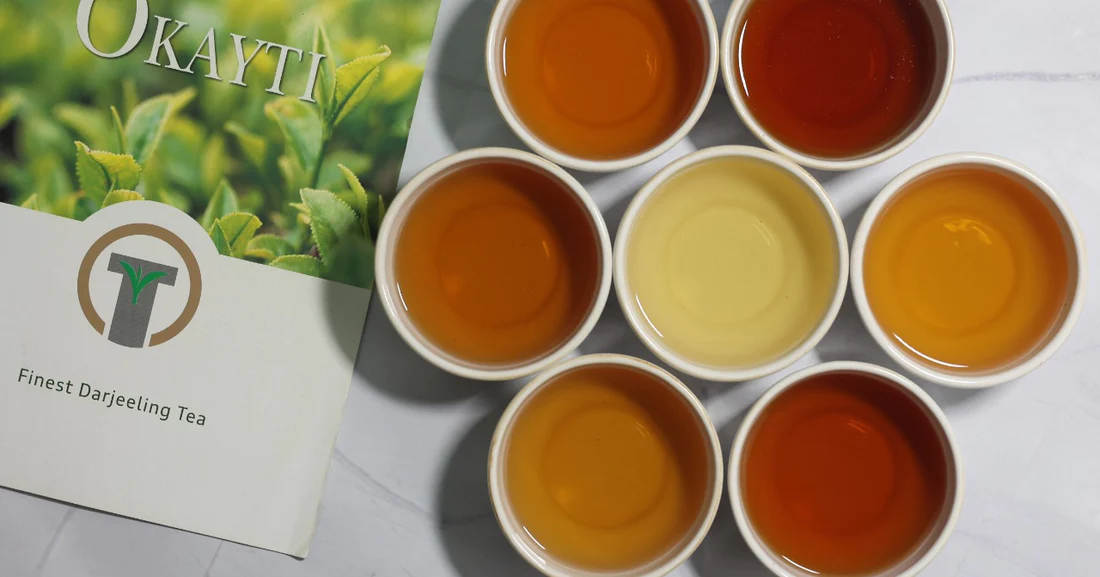Before delving into the luxurious bright golden cup that the Darjeeling Second Flush Tea steeps, we might have to explain a little bit about the seasonal flushes that the tea estates in Darjeeling produce. The extraordinary seasonal flushes of Darjeeling are famous globally for their distinct fragrance and flavour profile that depends massively on when and where the leaves were processed. At the advent of spring, when the temperature rises above 10 degrees centigrade, the hibernating tea bushes wake from their slumber.
On the further rise of temperature, they start shooting their first flush. Smaller than usual leaves, the first flush is packed with antioxidants and flavonoids. The flavour is brisk with hints of spring flowers and mild astringency. Then comes the Second Flush, which is also known as the Summer Flush. The succulent and bigger leaves of this flush are known for the elusive muscatel notes enveloped in a fruity overtone. After the Darjeeling Second Flush Tea comes the Autumn Flush, the last flush of the season. Autumn Flush teas are wholesome with a fuller body and a woody touch to them.
Every seasonal flush has a characteristic flavour profile true only to that particular flush and tea connoisseurs according to their palates prefer specific seasonal teas. Some go for the floral first flush while some go for the wholesome and nutty autumn flush. To each his own, there is an opulent orthodox tea for every individual.
What is special about Darjeeling Second Flush Tea
Darjeeling Second Flush Tea, true to its name encapsulates the bright summer vibes in its fragrance and flavours. The nuanced sweetness of summer fruits enlivens the palate while the revered muscatel notes hit in all the right places. A soothingly refreshing cup of Second Flush entails a complex yet delightful amalgamation of mild astringency coupled with nuanced muscatel texture and an incredibly rich aftertaste. It is once and for all an ultimately luxurious experience to sip on the tea nurtured in the heart of the mountains and blessed with the modest climate. The brilliant orange liquor of Second Flush tea is well-rounded and full-bodied with a cedar finish to it.
The craftsmanship at Okayti is extraordinarily elite with experienced individuals supervising every step of processing the succulent and flavourful Darjeeling Second Flush Tea. The process starts with choosing the right section of the estate. The manager keeps a keen eye on the entire estate spread over undulating hills with varying altitudes. There are sections which receive more sunlight than others and also with varying micro-weathers.
It is important to decide which leaves can be processed to harbour the optimum fragrance and flavour, timing is everything. After deciding on the section, the leaves are plucked by experienced workers and they are hurried to the factory where all the necessary steps follow. There is no standard time for withering, rolling, oxidizing and drying the tea leaves. The experienced senses of the supervisor are what turn the green leaves into the most opulent of orthodox Darjeeling Second Flush Tea.
Okayti Oriental Beauty is one such magnificent piece of art grown and processed at Okayti Tea Estate. It is the most premium Second Flush Teas that Okayti has ever produced. The two and a bud turn bright brown on the right amount of oxidation and steep a cup in a brilliant amber hue with fragrance and flavours that are unparalleled.
How to Make Second Flush Tea?
Unlike any other beverage, brewing Darjeeling second flush tea recipe is an experience. As the cups slowly cool down, there are minute changes in the overall characteristics, and the overpowering fragrance and subtle flavours render an extraordinary and rich experience. 3 gm of Second Flush tea should be brewed in 10oz of water at 195-200 F, and it tastes best without any sweetener or milk. It can be paired with light snacks or freshly cut fruits that cannot go wrong.
All said, isn’t it time to sip the precious whole-leaf orthodox and organic Second Flush teas? Find here the most prized Second Flush of Okayti.
Frequently Asked Questions
What is second-flush Darjeeling tea?
One of the finest Darjeeling tea known for its pristine taste and aroma. it is plucked in the month of mid-May to mid-June.
Which is better Darjeeling tea first flush or second flush?
Both are the top of the line Darjeeling Tea. Darjeeling First Flush Tea is plucked from mid-March to mid-April after the dormant winter season while Darjeeling second flush tea is plucked in mid-May to mid-June. Darjeeling first-flush tea can be considered better compared to second-flush due to its delicate taste and younger/tender leaves.
What does 2nd flush tea mean?
The second flush indicates the time period of plucking leaves i.e. mid-May to mid-June.
What does Darjeeling second flush tea taste like?
it is a full-bodied cup with overwhelming notes of muscatel and offers gentle sweetness in every sip.



One thought on “Single Estate Darjeeling Second Flush Tea – A Blissful Melange Of Luxury And Lusciousness”